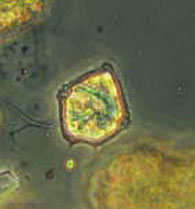
Nutrition
Many dinoflagellates are either photosynthetic, photoautotrophic, or heterotrophic. Gonyaulax catenella happens to be photoautotrophic, meaning this organism converts light into food energy through photosynthesis. A simple chemical equation to describe photosynthesis is as follows: carbon dioxide + water + light ---> produces glucose and oxygen. Another organism that uses photosynthesis to acquire nutrients is the Bracken Fern. Check it out!

Zoofari, Wikimedia Commons, 2010.
Unlike other dinoflagellates, Gonyaulax catenella does not possess
an eyespot. Instead, photosynthetic regions are located near the
base of its flagella. Chloroplasts (a photosynthesizing organelle)
contained within the lower body of the protist do the work of
converting light energy into chemical energy. Within the
chloroplasts are pigments for trapping light. These pigments are
chlorophyll a, chlorophyll c, small amounts of diatoxanthin,
diadinoxanthin, and peridinin— a xanthophyll (carotenoid) that is
unique to dinoflagellates. To access their light source, G. Catenella
can swim with a propulsion movement due to their flagella. Cells
form dense clusters near the ocean's surface, where they are able to
easily photosynthesize. During the night, they take advantage of the
higher nutrient concentration at greater depths due to differential
light absorption of the water. The cells migrate through gradients
of different spectrums, obtaining different nutrient
concentrations. Dinoflagellates can also photosynthesize
with the help of circadian rhythms. These circadian systems respond
to both short and long wavelengths of light. The combined action of
red and blue light also active the chlorophyll.

© Smithsonian Environmental Research
Center
Knowing how well G.
catenella can acquire nutrients, take a look at their life
complex cycle by going to the
Reproduction page.
Curious to know how the
Daffidil or
E. coli reproduction cycles differ from that of a
protist? Click the links to find out!